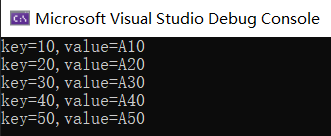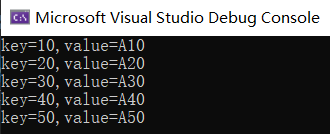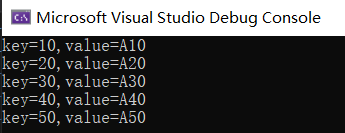本篇内容主要讲解“Dictionary遍历的使用方法有哪些”,感兴趣的朋友不妨来看看。本文介绍的方法操作简单快捷,实用性强。下面就让小编来带大家学习“Dictionary遍历的使用方法有哪些”吧!
使用 foreach 遍历
为了方便演示,先上一段测试代码:
var dict = new Dictionary<int, string>() { [10] = "A10", [20] = "A20", [30] = "A30", [40] = "A40", [50] = "A50" };1. 直接 foreach dict
如果要拿百分比说话,估计有 50%+ 的小伙伴用这种方式,为啥,简单粗暴呗,其他没什么好说的,直接上代码:
foreach (var item in dict) { Console.WriteLine($"key={item.Key},value={item.Value}"); }
这里的 item 是底层在 MoveNext 的过程中用 KeyValuePair 包装出来的,如果你不信的话,看下源码呗:
public bool MoveNext() { while ((uint)_index < (uint)_dictionary._count) { ref Entry reference = ref _dictionary._entries[_index++]; if (reference.next >= -1) { _current = new KeyValuePair<TKey, TValue>(reference.key, reference.value); return true; } } }2. foreach 中 使用 KeyPairValue 解构
刚才你也看到了 item 是 KeyValuePair 类型,不过的是 netcore 对 KeyValuePair 进行了增强,增加了 Deconstruct 函数用来解构 KeyValuePair,代码如下:
public readonly struct KeyValuePair<TKey, TValue> { private readonly TKey key; private readonly TValue value; public TKey Key => key; public TValue Value => value; public KeyValuePair(TKey key, TValue value) { this.key = key; this.value = value; } public void Deconstruct(out TKey key, out TValue value) { key = Key; value = Value; } }有了这个解构函数,你就可以在遍历的过程中直接拿到 key,value,而不是包装的 KeyValuePair,这在 netframework 中可是不行的哈,实现代码如下:
foreach ((int key, string value) in dict) { Console.WriteLine($"key={key},value={value}"); }
3. foreach keys
前面的例子都是直接对 dict 进行 foreach,其实你还可以对 dict.keys 进行 foreach 遍历,然后通过遍历出的 key 对 dict 进行类索引器读取,代码如下:
foreach (var key in dict.Keys) { Console.WriteLine($"key={key},value={dict[key]}"); }
说到这里,不知道你是否有一个潜意识,那就是 dict 只能通过 foreach 进行遍历,真相是不是这样的呢? 要寻找答案,还是回头看一下 foreach 是如何进行遍历的。
public struct Enumerator : IEnumerator<KeyValuePair<TKey, TValue>>, IDisposable, IEnumerator, IDictionaryEnumerator { public bool MoveNext() { while ((uint)_index < (uint)_dictionary._count) { ref Entry reference = ref _dictionary._entries[_index++]; if (reference.next >= -1) { _current = new KeyValuePair<TKey, TValue>(reference.key, reference.value); return true; } } _index = _dictionary._count + 1; _current = default(KeyValuePair<TKey, TValue>); return false; }}仔细看这个 while 循环,你就应该明白,本质上它也是对 entries 数组进行遍历,那底层都用了 while,我是不是可以用 for 来替换然后循环 dict 呢?哈哈,反正就是模仿呗。
使用 for 遍历
为了把 MoveNext 中的代码模拟出来,重点在于这条语句: ref Entry reference = ref _dictionary._entries[_index++];, 其实很简单,_entries 数组内容的提取可以用 Linq 的 ElementAt 方法,是不是~ ,改造后的代码如下:
for (int i = 0; i < dict.Count; i++) { (int key, string value) = dict.ElementAt(i); Console.WriteLine($"key={key},value={dict[key]}"); }
接下来是不是很好奇这个 ElementAt 扩展方法是如何实现的,一起看看源码吧。
public static TSource ElementAt<TSource>(this IEnumerable<TSource> source, int index) { IList<TSource> list = source as IList<TSource>; if (list != null) { return list[index]; } if (index >= 0) { using (IEnumerator<TSource> enumerator = source.GetEnumerator()) { while (enumerator.MoveNext()) { if (index == 0) { return enumerator.Current; } index--; } } } }到此,相信大家对“Dictionary遍历的使用方法有哪些”有了更深的了解,不妨来实际操作一番吧!这里是亿速云网站,更多相关内容可以进入相关频道进行查询,关注我们,继续学习!
免责声明:本站发布的内容(图片、视频和文字)以原创、转载和分享为主,文章观点不代表本网站立场,如果涉及侵权请联系站长邮箱:is@yisu.com进行举报,并提供相关证据,一经查实,将立刻删除涉嫌侵权内容。